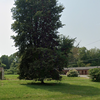Neighbors with water aid those without
ALTAMONT — For the owners of four different buildings along Maple Avenue near Main Street, warmer weather can’t come soon enough. They have been without running water for about four weeks, ever since their pipes froze.
An additional building owner, Marc Smith, of Altamont Antiques at 135 Maple Ave., also had a pipe that froze on March 7, but was able to thaw it out on March 19.
One of those still without water — Barry Gasparro, who, together with his life partner Rhonda Flansburg, co-owns ReNue Spa at 119 Maple Ave. — is borrowing water, through a hose, from his next-door neighbors. Meanwhile, at his other business, BG Automotive at 20 Village Auto Lane in Voorheesville, Gasparro is supplying water to a frozen-out neighboring business, Ingleston Autobody Works.
Another of the businesses in Altamont that remains without water is The Altamont Enterprise, which occupies a complex of two joined buildings on two separate water meters, at 123 Maple Ave. The pipe supplying one of the buildings froze on Feb. 23, but publisher James E. Gardner has been able to run a hose from one building to the other, so that both have water.
Altamont Public Works Superintendent Jeffrey Moller told The Enterprise that, according to Village Law, the village is responsible only for making needed repairs to the water mains. Homeowners are responsible for any needed repairs to the pipes that run from the main all the way into the residence.
This differs, he said, from the situation in towns such as Guilderland. In Guilderland, for instance, he said, “The town is responsible from the main to the shutoff that is in the lawn. Then residents are responsible from that shutoff to the house.”
Moller said he believes there were originally a total of eight buildings in the village without water.
Asked if the village is working to fix the still-frozen lines, Moller replied, “We’ve tried to help them as much as we can. But we’re kind of limited, too. If we go on people’s property and start working on it, then we’re breaking the law too, you know?”
Showdown in Troy
Water pipes have featured heavily in Capital Region news lately because of a situation in the Lansingburgh section of Troy when about 60 residences were left without water for days, as a result of pipe freezes.
Councilman Jim Gordon recounted to The Enterprise what happened in Troy, where the city is responsible for the portion of the pipes from the main to the shutoff, and the homeowner is responsible from the shutoff to the house.
In Troy, Gordon said, all the freezes were in the portion of the pipes owned by the city, between the main and the shutoff. Yet the mayor and the city insisted that they would not make the repairs, and that homeowners were responsible.
Many homeowners got the pipes thawed out, at their own expense. Others objected. Some had already spent almost $1,000, Gordon said, getting inspections or having their own pipes thawed out, only to run into a problem when they reached the still-frozen city-owned portion.
Early in May, both the city council and the county legislature passed resolutions urging the city to adhere to the city code by taking responsibility for maintenance of the pipes between the mains and the shutoffs. The city refused to back down, but the situation was resolved, for now, when donations from individuals in the community and from plumbing contractors came in that allowed the work to be done.
Gordon said, “I think what we learned was that there is a potential for a problem. But the solution is kind of inexpensive, if the city incorporates it into their requirements.”
The method used this time, he said, was “basically hot water fed through a pipe. There was no digging and no electricity used. It was all done by heating a hose into the water line, and when you encountered a blockage, hot water was jetted in to melt the ice, and that process just continued until water flowed into the house.”
He added that the equipment used cost about $2,500 and that it took “a couple of hours” to thaw out a single residence.
Closer to home
In Altamont, Moller said, the pipes running from the mains to the residences are actually owned by the homeowners.
Moller said that none of the village’s water mains have frozen. “We’ve had main breaks, but none of them froze.”
He specified that the reason for those breaks was because of a phenomenon he called “frost heaves,” when the ground shifts as a result of the frost.
There were two breaks, on Western Avenue and Sand Street, both of which have been repaired.

The average cost for repairing a water-main break in the village, according to the village-produced document “A brief Village water system history,” is $2,000 in labor and material, not including equipment costs.
At The Enterprise, Gardner was able simply to run a hose from the faucet in the building that still had water, across the floor and through a window, and then hook it to a sink in the back of the building with the frozen pipes — which houses the editorial offices — so that it would have water as well.
“But beyond that, I’m not going to expend a lot of frustration and energy chasing this thing, until I have to,” Gardner said. “I’ve ignored it and let it go, and hopefully it will thaw out soon.”
Gardner has worked at The Enterprise, at 123 Maple Ave., for 60 years and says that this is the first winter that he can remember when there has been any issue with the water pipes.
Gasparro of ReNue Spa, next door to The Enterprise, said that he spent close to $1,000 working — unsuccessfully — with several plumbers. “I’m pretty handy. I own an automotive repair shop and have all the access to tools and stuff.” But one plumber took a look at the job and backed away from it, he said, since it would involve crossing the road and possibly getting expensive tools stuck in the pipe.
Gasparro consulted a specialist, Joel Vadney of Vadney’s Underground Plumbing in Delmar.
Vadney told The Enterprise, “One of the drawbacks on Maple Avenue is that the lines are so long that they’re very hard to get open. So what we have to do often is dig them up in the middle — at the shutoff — so you can heat in both directions. That way, you’ve split the distance. Basically you can only thaw so far.”
Vadney had suggested digging at Gasparro’s shutoff. But Gasparro nixed that idea, he said, because, “once you start digging in town, it stirs up all sorts of liability issues.”
Gasparro said that he is very grateful to his “very kind” neighbors, Stephen and Debra Sivack, and that he offered to pay their water bill for the next year. They refused, he said, “but we’ll do something for them.” He said that Assistant Superintendent of Public Works Larry Adams had also gone “above and beyond,” checking on the building, without being asked to, while the owners were on a vacation they had scheduled long before.

Mark Ingleston of Ingleston Autobody Works in Voorheesville, near Gasparro’s other business, BG Automotive, is also very grateful to Gasparro, who has been providing the water for his body shop. Ingleston said, “We have some 30-gallon barrels that we have been filling and transporting down, and pouring off as we need.” He pointed out that he’s lucky that it’s not a residence and that their water needs are limited to wet sanding and the utilities such as the toilets. “I’m hoping for spring to get here in a hurry,” he said.
Smith, at 135 Maple Ave., was one of the only ones who has managed to thaw his frozen supply line.
He did it by running hot water through it, using an on-demand hot-water boiler that he was able to hook up to run water down into the pipe from a neighbor’s house.
At least one resident has also been affected by the freeze. Kelly Pickering of 115 Maple Ave. has been getting water from her neighbors, Greg and Kelly Tymchyn, who own 109 Maple. A hose crosses over Pickering’s driveway and connects the spigots outside the two houses. Water then passes through Pickering’s hot-water heater.
“We have to run the faucets at night, to keep it from freezing up,” she said. Leave them dripping? she was asked. “No, actually running,” she said.
She had a plumber come out and work on the pipes for about 10 hours. He got about 50 or 55 feet from the house, “basically siphoning hot water in there,” but he was unable to get all the way to the main, she said.
“I don’t know that I have any choice now” except to wait for spring, Pickering said. She mentioned how grateful she is to the Tymchyns, who have been “extremely kind neighbors” all the years that Pickering has lived on Maple Avenue. She plans to reimburse them for the inevitable dramatic spike in their water bill.
“It’s kind of disconcerting to think that this may go on for several more weeks,” she added.
Vadney said that, while there have been some calls in Voorheesville, there have only been a couple of freezes that he knows about there. So the situation there is not as bad as it has been in Altamont.
But in Altamont, too, he said, this doesn’t begin to compare to 1994, when “we probably went on two or three a day” and did 30 or 35 in a single month.
Indeed, according to accuweather.com, February 2015 was the Capital Region’s second-coldest month on record, with an average temperature of 12.7º F, and the coldest month on record since January of 1994, which presumably may have been even colder.
Substandard mains
Almost one-quarter of the water mains in the village of Altamont are considered substandard and date back to the 1930s. The village itself notes, in its water system history document, that these water mains “will not provide enough water flow at the hydrants in case of a fire.”
A map produced by the village shows the quality of the different water mains throughout the village. (See graphic.)
Substandard mains, dating from 1930, serve portions of other streets and the entirety of these streets: Lincoln Avenue, Euclid Avenue, Park Street, Lark Street, Grand Street, Sand Street, Mountaindale Court, and Fairview Avenue.
Asked how much it would cost for the village to replace all of the substandard water mains, Moller said that he had no idea.
Altamont Fire Chief Robert White agreed that the water mains on side roads in the village may be substandard.
“We still tap into those mains,” he said, “even though we may not get as much water out of them.”
He said, though, that these substandard mains are not cause for concern at all. He noted that the fire department in Altamont is accustomed to working without the benefit of any fire hydrants at all.
There are hydrants within the one square mile of the village proper, but in the remaining 25 square miles that the department protects, there are no hydrants, so fires are fought with a combination of trucks; as well as with “dry hydrants,” which are ponds on residents’ properties equipped with plumbing that fire trucks can hook into.
White mentioned that the department’s newest truck holds 3,000 gallons of water; another holds 1,000; and another, 750. The trucks’ hoses can also be hooked into one another, to shuttle water. If needed, the department can also call on mutual-aid companies for additional water sources.
In the village, where many streets are narrow, trucks don’t all need to be on the street where the fire is occurring; some can lay in their hoses from an adjacent street.
The water system history document notes that the village has been keeping records on water main breaks since 2003, and that there have been 74 since that time. Sixty-five percent of those breaks have been in mains installed in the 1930s.
The two main breaks this year were, as noted, on Western Avenue and Sand Street. According to the village’s water main map, all of the mains on Sand Street are substandard. A portion of Western Avenue’s mains are substandard, although The Enterprise was unable to confirm before going to press whether the Western Avenue break was in this section.
Possible cause and low-cost solutions
Vadney said that some people have suggested that the pipes may not be buried deep enough on Maple Avenue.
He added that, while he does think that is likely, he also thinks a more important contributing factor may be the upgrades done to Maple Avenue and Main Street about 10 years ago — specifically, the addition of more and larger storm drains.
“Those storm drains,” he said, “are open grates and open pipe. The air blows through those pipes and freezes the pipe around them. Cold air goes down into them and freezes the ground faster.”
Gasparro agreed. “That is the theory that we all believe,” he said. He pointed out that Smith, who had succeeded in thawing out his pipes, didn’t have the storm drains at his property. “His probably wasn’t frozen as hard as ours.”
Vadney said that he had heard about one town —“the name escapes me”— that had implemented a low-tech, low-cost solution to this same problem of underground cold exacerbated by large drains. “They put insulation into the storm drains during the winter, to block the cold-air draft,” he said.
The drains are not needed for snow, only for rain. “Yeah, it’s another maintenance issue,” he said, “because you need to keep an eye on the forecast and take it out if you’re expecting rain, but think how much you would save, over spending millions of dollars to replace your infrastructure.”
Gasparro suggested that, next time around, better communication would help.
“Maybe an insert could be put in with everybody’s next water bill,” he said, “telling them that the next time this happens, anyone whose pipes freeze should immediately call the police or the village hall to let them know. Then there could be a system for announcing it, like putting up a billboard in the center of town, to let people know that they should let their water drip.” This time, nobody knew, he said, “so everybody froze.”
He continued drolly, “Ironically, it was your business that froze first. A newspaper that didn’t tell anybody. What’s up with that?”
Village water history
ALTAMONT — Altamont incorporated in 1890 with 543 residents and built its first reservoir in 1893, using wooden pipes to transport water, according to information given at Congressman Paul Tonko’s roundtable talk last week. In 1909, the village replaced 7,000 feet of wooden transmission mains with 4-inch cast-iron pipes, completing the replacement of wooden pipes in 1930.
Seven years later, the village built its second reservoir and a 40,000-gallon sedimentation tank. In 1957, when the village had 1,257 residents, water supply became a problem; in 1961, improvements began to the main reservoir and filter house, and a 500,000-gallon covered steel storage tank was built.
Currently, Altamont, a mile-square village, has three drilled wells at two sites that average 250 gallons per minute per well, distributed through 15 miles of water main: 23 percent was installed in the 1930s, 14 percent in the 1950s, 8 percent in the 1970s, 25 percent in the 1980s, and 30 percent in the first decade of this century.
The 1930s pipes are substandard; 65 percent of the breaks are in those lines, which do not provide enough water flow at hydrants in case of fire.
The village has 818 service connections serving about 2,000 people with an average daily use of 167,000 gallons.
This year’s water department budget is about $202,000.
Updated on April 20, 2015: The section on the effects substandard water mains have on firefighting was added after Fire Chief Robert White responded.


